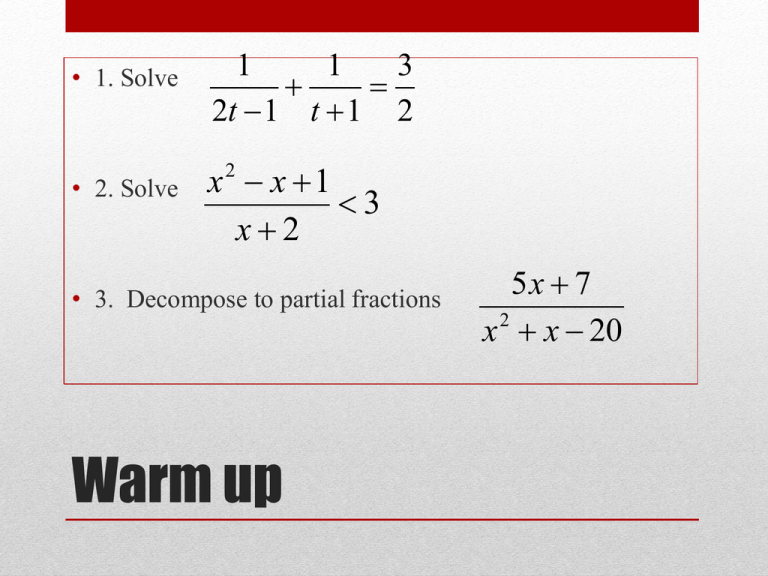Lesson 4-7 Radical Equations and Inequalities
advertisement

• 1. Solve • 2. Solve 1 1 3 2t 1 t 1 2 x x 1 3 x2 2 • 3. Decompose to partial fractions Warm up 5x 7 x 2 x 20 Lesson 4-7 Radical Equations and Inequalities Objective: To solve radical equations and inequalities A radical equation contains a variable within a radical. Recall that you can solve quadratic equations by taking the square root of both sides. Similarly, radical equations can be solved by raising both sides to a power. Remember! For a square root, the index of the radical is 2. Solve Radical Equations Solve . Original equation Add 1 to each side to isolate the radical. Square each side to eliminate the radical. Find the squares. Add 2 to each side. Example 1 Solve Radical Equations Check Original equation ? Replace y with 38. Simplify. Answer: The solution checks. The solution is 38. Example 1 Raising each side of an equation to an even power may introduce extraneous solutions. Helpful Hint You can use the intersect feature on a graphing calculator to find the point where the two curves intersect. Method 1 Use algebra to solve the equation. Step 1 Solve for x. Square both sides. 2x + 14 = x2 + 6x + 9 0 = x2 + 4x – 5 Factor. 0 = (x + 5)(x – 1) Write in standard form. Solve for x. x + 5 = 0 or x – 1 = 0 x = –5 or x = 1 Example 2 Simplify. Method 1 Use algebra to solve the equation. Step 2 Use substitution to check for extraneous solutions. 2 –2 x 4 4 Because x = –5 is extraneous, the only solution is x = 1. Example 2 Solve the equation. Method 2 Use a graphing calculator. Let Y1 = and Y2 = x +3. The graphs intersect in only one point, so there is exactly one solution. The solution is x = 1. Example 2 3 7 3 x 11 • Solve Practice • Solve: Practice x 1 1 2 x 12 A radical inequality is an inequality that contains a variable within a radical. You can solve radical inequalities by graphing or using algebra. Remember! A radical expression with an even index and a negative radicand has no real roots. Solve . Method 1 Use algebra to solve the inequality. Step 1 Solve for x. Subtract 2. Square both sides. Simplify. x–3≤9 x ≤ 12 Example 3 Solve for x. Method 1 Use algebra to solve the inequality. Step 2 Consider the radicand. x–3≥0 The radicand cannot be negative. x≥3 The solution of 12, or 3 ≤ x ≤ 12. Example 3 Solve for x. is x ≥ 3 and x ≤ Solve . Method 2 Use a graph and a table. On a graphing calculator, let Y1 = and Y2 = 5. The graph of Y1 is at or below the graph of Y2 for values of x between 3 and 12. Notice that Y1 is undefined when < 3. The solution is 3 ≤ x ≤ 12. Example 3 Method 1 Use algebra to solve the inequality. Step 1 Solve for x. Cube both sides. x+2≥1 x ≥ –1 Example 4 Solve for x. Method 1 Use algebra to solve the inequality. Step 2 Consider the radicand. x+2≥1 x ≥ –1 The solution of Example 4 The radicand cannot be negative. Solve for x. is x ≥ –1. Solve . Method 1 Use a graph and a table. On a graphing calculator, let Y1 = and Y2 = 1. The graph of Y1 is at or above the graph of Y2 for values of x greater than –1. Notice that Y1 is undefined when < –2. The solution is x ≥ –1. Example 4 • Solve Practice 6x 5 4 • Holt Algebra 2 • Glencoe Algebra 2 Sources





